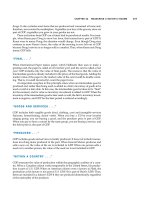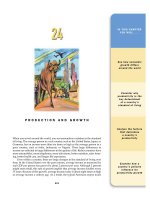Ten Principles of Economics - Part 52
Bạn đang xem bản rút gọn của tài liệu. Xem và tải ngay bản đầy đủ của tài liệu tại đây (238.33 KB, 10 trang )
Examine how a
country’s policies
influence its
productivity growth
Consider why
productivity is the
key determinant
of a country’s
standard of living
IN THIS CHAPTER
YOU WILL . . .
See how economic
growth differs
around the world
Analyze the factors
that determine
a country’s
productivity
When you travel around the world, you see tremendous variation in the standard
of living. The average person in a rich country, such as the United States, Japan, or
Germany, has an income more than ten times as high as the average person in a
poor country, such as India, Indonesia, or Nigeria. These large differences in
income are reflected in large differences in the quality of life. Richer countries have
more automobiles, more telephones, more televisions, better nutrition, safer hous-
ing, better health care, and longer life expectancy.
Even within a country, there are large changes in the standard of living over
time. In the United States over the past century, average income as measured by
real GDP per person has grown by about 2 percent per year. Although 2 percent
might seem small, this rate of growth implies that average income doubles every
35 years. Because of this growth, average income today is about eight times as high
as average income a century ago. As a result, the typical American enjoys much
PRODUCTION AND GROWTH
529
530 PART NINE THE REAL ECONOMY IN THE LONG RUN
greater economic prosperity than did his or her parents, grandparents, and great-
grandparents.
Growth rates vary substantially from country to country. In some East Asian
countries, such as Singapore, South Korea, and Taiwan, average income has risen
about 7 percent per year in recent decades. At this rate, average income doubles
every ten years. These countries have, in the length of one generation, gone from
being among the poorest in the world to being among the richest. By contrast, in
some African countries, such as Chad, Ethiopia, and Nigeria, average income has
been stagnant for many years.
What explains these diverse experiences? How can the rich countries be sure
to maintain their high standard of living? What policies should the poor countries
pursue to promote more rapid growth in order to join the developed world? These
are among the most important questions in macroeconomics. As economist Robert
Lucas put it, “The consequences for human welfare in questions like these are sim-
ply staggering: Once one starts to think about them, it is hard to think about any-
thing else.”
In the previous two chapters we discussed how economists measure macro-
economic quantities and prices. In this chapter we start studying the forces that
determine these variables. As we have seen, an economy’s gross domestic product
(GDP) measures both the total income earned in the economy and the total expen-
diture on the economy’s output of goods and services. The level of real GDP is a
good gauge of economic prosperity, and the growth of real GDP is a good gauge of
economic progress. Here we focus on the long-run determinants of the level and
growth of real GDP. Later in this book we study the short-run fluctuations of real
GDP around its long-run trend.
We proceed here in three steps. First, we examine international data on real
GDP per person. These data will give you some sense of how much the level and
growth of living standards vary around the world. Second, we examine the role of
productivity—the amount of goods and services produced for each hour of a work-
er’s time. In particular, we see that a nation’s standard of living is determined by
the productivity of its workers, and we consider the factors that determine a
nation’s productivity. Third, we consider the link between productivity and the
economic policies that a nation pursues.
ECONOMIC GROWTH AROUND THE WORLD
As a starting point for our study of long-run growth, let’s look at the experiences
of some of the world’s economies. Table 24-1 shows data on real GDP per person
for 13 countries. For each country, the data cover about a century of history. The
first and second columns of the table present the countries and time periods. (The
time periods differ somewhat from country to country because of differences in
data availability.) The third and fourth columns show estimates of real GDP per
person about a century ago and for a recent year.
The data on real GDP per person show that living standards vary widely from
country to country. Income per person in the United States, for instance, is about 8
times that in China and about 15 times that in India. The poorest countries have
average levels of income that have not been seen in the United States for many
CHAPTER 24 PRODUCTION AND GROWTH 531
decades. The typical citizen of China in 1997 had about as much real income as the
typical American in 1870. The typical person in Pakistan in 1997 had about one-
half the real income of a typical American a century ago.
The last column of the table shows each country’s growth rate. The growth
rate measures how rapidly real GDP per person grew in the typical year. In the
United States, for example, real GDP per person was $3,188 in 1870 and $28,740 in
1997. The growth rate was 1.75 percent per year. This means that if real GDP per
person, beginning at $3,188, were to increase by 1.75 percent for each of 127 years,
it would end up at $28,740. Of course, real GDP per person did not actually rise
exactly 1.75 percent every year: Some years it rose by more and other years by less.
The growth rate of 1.75 percent per year ignores short-run fluctuations around the
long-run trend and represents an average rate of growth for real GDP per person
over many years.
The countries in Table 24-1 are ordered by their growth rate from the most to
the least rapid. Japan tops the list, with a growth rate of 2.82 percent per year. A
hundred years ago, Japan was not a rich country. Japan’s average income was only
somewhat higher than Mexico’s, and it was well behind Argentina’s. To put the
issue another way, Japan’s income in 1890 was less than India’s income in 1997.
But because of its spectacular growth, Japan is now an economic superpower, with
average income only slightly behind that of the United States. At the bottom of the
list of countries is Bangladesh, which has experienced growth of only 0.78 percent
per year over the past century. As a result, the typical resident of Bangladesh con-
tinues to live in abject poverty.
Because of differences in growth rates, the ranking of countries by income
changes substantially over time. As we have seen, Japan is a country that has risen
Table 24-1
R
EAL
GDP
PER
P
ERSON
R
EAL
GDP
PER
P
ERSON
G
ROWTH
R
ATE
C
OUNTRY
P
ERIOD AT
B
EGINNING OF
P
ERIOD
a
AT
E
ND OF
P
ERIOD
a
PER YEAR
Japan 1890–1997 $1,196 $23,400 2.82%
Brazil 1900–1997 619 6,240 2.41
Mexico 1900–1997 922 8,120 2.27
Germany 1870–1997 1,738 21,300 1.99
Canada 1870–1997 1,890 21,860 1.95
China 1900–1997 570 3,570 1.91
Argentina 1900–1997 1,824 9,950 1.76
United States 1870–1997 3,188 28,740 1.75
Indonesia 1900–1997 708 3,450 1.65
India 1900–1997 537 1,950 1.34
United Kingdom 1870–1997 3,826 20,520 1.33
Pakistan 1900–1997 587 1,590 1.03
Bangladesh 1900–1997 495 1,050 0.78
a
Real GDP is measured in 1997 dollars.
S
OURCE
: Robert J. Barro and Xavier Sala-i-Martin, Economic Growth (New York: McGraw-Hill, 1995), tables 10.2 and 10.3; World Development Report
1998/99, table 1; and author’s calculations.
T
HE
V
ARIETY OF
G
ROWTH
E
XPERIENCES
532 PART NINE THE REAL ECONOMY IN THE LONG RUN
relative to others. One country that has fallen behind is the United Kingdom. In
1870, the United Kingdom was the richest country in the world, with average
income about 20 percent higher than that of the United States and about twice that
of Canada. Today, average income in the United Kingdom is below average
income in its two former colonies.
These data show that the world’s richest countries have no guarantee they will
stay the richest and that the world’s poorest countries are not doomed forever to
remain in poverty. But what explains these changes over time? Why do some
countries zoom ahead while others lag behind? These are precisely the questions
that we take up next.
QUICK QUIZ: What is the approximate growth rate of real GDP per person
in the United States? Name a country that has had faster growth and a country
that has had slower growth.
PRODUCTIVITY: ITS ROLE AND DETERMINANTS
Explaining the large variation in living standards around the world is, in one
sense, very easy. As we will see, the explanation can be summarized in a single
word—productivity. But, in another sense, the international variation is deeply
It may be tempting to dismiss
differences in growth rates as
insignificant. If one country
grows at 1 percent while anoth-
er grows at 3 percent, so what?
What difference can 2 percent
make?
The answer is: a big differ-
ence. Even growth rates that
seem small when written in per-
centage terms seem large after
they are compounded for many
years. Compounding refers to
the accumulation of a growth
rate over a period of time.
Consider an example. Suppose that two college gradu-
ates—Jerry and Elaine—both take their first jobs at the age
of 22 earning $30,000 a year. Jerry lives in an economy
where all incomes grow at 1 percent per year, while Elaine
lives in one where incomes grow at 3 percent per year.
Straightforward calculations show what happens. Forty
years later, when both are 62 years old, Jerry earns
$45,000 a year, while Elaine earns $98,000. Because of
that difference of 2 percentage points in the growth rate,
Elaine’s salary is more than twice Jerry’s.
An old rule of thumb, called the rule of 70, is helpful in
understanding growth rates and the effects of compounding.
According to the rule of 70, if some variable grows at a rate
of x percent per year, then that variable doubles in approxi-
mately 70/x years. In Jerry’s economy, incomes grow at 1
percent per year, so it takes about 70 years for incomes to
double. In Elaine’s economy, incomes grow at 3 percent per
year, so it takes about 70/3, or 23, years for incomes to
double.
The rule of 70 applies not only to a growing economy
but also to a growing savings account. Here is an example:
In 1791, Ben Franklin died and left $5,000 to be invested
for a period of 200 years to benefit medical students and
scientific research. If this money had earned 7 percent per
year (which would, in fact, have been very possible to do),
the investment would have doubled in value every 10 years.
Over 200 years, it would have doubled 20 times. At the end
of 200 years of compounding, the investment would have
been worth 2
20
ϫ $5,000, which is about $5 billion. (In fact,
Franklin’s $5,000 grew to only $2 million over 200 years
because some of the money was spent along the way.)
As these examples show, growth rates compounded
over many years can lead to some spectacular results. That
is probably why Albert Einstein once called compounding
“the greatest mathematical discovery of all time.”
FYI
The Magic of
Compounding
and the
Rule of 70
CHAPTER 24 PRODUCTION AND GROWTH 533
puzzling. To explain why incomes are so much higher in some countries than in
others, we must look at the many factors that determine a nation’s productivity.
WHY PRODUCTIVITY IS SO IMPORTANT
Let’s begin our study of productivity and economic growth by developing a sim-
ple model based loosely on Daniel DeFoe’s famous novel Robinson Crusoe. Robin-
son Crusoe, as you may recall, is a sailor stranded on a desert island. Because
Crusoe lives alone, he catches his own fish, grows his own vegetables, and makes
his own clothes. We can think of Crusoe’s activities—his production and con-
sumption of fish, vegetables, and clothing—as being a simple economy. By exam-
ining Crusoe’s economy, we can learn some lessons that also apply to more
complex and realistic economies.
What determines Crusoe’s standard of living? The answer is obvious. If Cru-
soe is good at catching fish, growing vegetables, and making clothes, he lives well.
If he is bad at doing these things, he lives poorly. Because Crusoe gets to consume
only what he produces, his living standard is tied to his productive ability.
The term productivity refers to the quantity of goods and services that a work-
er can produce for each hour of work. In the case of Crusoe’s economy, it is easy to
see that productivity is the key determinant of living standards and that growth in
productivity is the key determinant of growth in living standards. The more fish
Crusoe can catch per hour, the more he eats at dinner. If Crusoe finds a better place
to catch fish, his productivity rises. This increase in productivity makes Crusoe
better off: He could eat the extra fish, or he could spend less time fishing and
devote more time to making other goods he enjoys.
The key role of productivity in determining living standards is as true for
nations as it is for stranded sailors. Recall that an economy’s gross domestic prod-
uct (GDP) measures two things at once: the total income earned by everyone in the
economy and the total expenditure on the economy’s output of goods and ser-
vices. The reason why GDP can measure these two things simultaneously is that,
for the economy as a whole, they must be equal. Put simply, an economy’s income
is the economy’s output.
Like Crusoe, a nation can enjoy a high standard of living only if it can produce
a large quantity of goods and services. Americans live better than Nigerians
because American workers are more productive than Nigerian workers. The
Japanese have enjoyed more rapid growth in living standards than Argentineans
because Japanese workers have experienced more rapidly growing productivity.
Indeed, one of the Ten Principles of Economics in Chapter 1 is that a country’s stan-
dard of living depends on its ability to produce goods and services.
Hence, to understand the large differences in living standards we observe
across countries or over time, we must focus on the production of goods and ser-
vices. But seeing the link between living standards and productivity is only the
first step. It leads naturally to the next question: Why are some economies so much
better at producing goods and services than others?
HOW PRODUCTIVITY IS DETERMINED
Although productivity is uniquely important in determining Robinson Crusoe’s
standard of living, many factors determine Crusoe’s productivity. Crusoe will be
productivity
the amount of goods and services
produced from each hour of a
worker’s time









